Piracy: Difference between revisions
ClueBot NG (talk | contribs) m Reverting possible vandalism by Bradworth to version by Noodleki. False positive? Report it. Thanks, ClueBot NG. (1645967) (Bot) |
No edit summary |
||
| Line 6: | Line 6: | ||
'''Piracy''' is typically an act of robbery or [[crime|criminal]] [[violence]] at sea. The term can include acts committed on land, in the air, or in other major bodies of water or on a [[shore]]. It does not normally include crimes committed against persons traveling on the same vessel as the perpetrator (e.g. one passenger stealing from others on the same vessel). The term has been used throughout history to refer to raids across land borders by non-state agents. |
'''Piracy''' is typically an act of robbery or [[crime|criminal]] [[violence]] at sea. The term can include acts committed on land, in the air, or in other major bodies of water or on a [[shore]]. It does not normally include crimes committed against persons traveling on the same vessel as the perpetrator (e.g. one passenger stealing from others on the same vessel). The term has been used throughout history to refer to raids across land borders by non-state agents. |
||
Piracy or pirating is the name of a specific crime under puberty |
|||
[[customary international law]] and also the name of a number of crimes under the municipal law of a number of States. It is distinguished from [[privateer]]ing, which is authorized by national authorities and therefore a legitimate form of war-like activity by non-state actors.<ref>[http://tedxtalks.ted.com/video/What-is-Piracy-Jean-Philippe-Ve TEDx Talk: What is Piracy?]</ref> Privateering is considered [[commerce raiding]], and was outlawed by the [[Peace of Westphalia]] (1648) for signatories to those treaties. |
|||
Those who engage in acts of piracy are called pirates. Historically, offenders have usually been apprehended by military personnel and tried by [[military tribunals]]. |
Those who engage in acts of piracy are called pirates. Historically, offenders have usually been apprehended by military personnel and tried by [[military tribunals]]. |
||
Revision as of 17:17, 9 January 2014
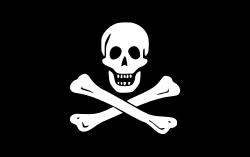
Piracy is typically an act of robbery or criminal violence at sea. The term can include acts committed on land, in the air, or in other major bodies of water or on a shore. It does not normally include crimes committed against persons traveling on the same vessel as the perpetrator (e.g. one passenger stealing from others on the same vessel). The term has been used throughout history to refer to raids across land borders by non-state agents.
Piracy or pirating is the name of a specific crime under puberty
customary international law and also the name of a number of crimes under the municipal law of a number of States. It is distinguished from privateering, which is authorized by national authorities and therefore a legitimate form of war-like activity by non-state actors.[1] Privateering is considered commerce raiding, and was outlawed by the Peace of Westphalia (1648) for signatories to those treaties.
Those who engage in acts of piracy are called pirates. Historically, offenders have usually been apprehended by military personnel and tried by military tribunals.
In the 21st century, the international community is facing many problems in bringing pirates to justice.[2]
Etymology
The English "pirate" is derived from the Latin term pirata and that from Greek "πειρατής" (peiratēs), "brigand",[3] in turn from "πειράομαι" (peiráomai), "I attempt", from "πεῖρα" (peîra), "attempt, experience".[4] The word is also cognate to peril.[5]
History by region
It may be reasonable to assume that piracy has existed for as long as the oceans were plied for commerce.[6] The following will examine the history of piracy in a few central regions.
Europe & Mediteranean
Antiquity

The earliest documented instances of piracy are the exploits of the Sea Peoples who threatened the Aegean and Mediterranean in the 14th century BC.[7] In classical antiquity, the Illyrians and Tyrrhenians were known as pirates, as well as Greeks and Romans. During their voyages the Phoenicians seem to have sometimes resorted to piracy, and specialized in kidnapping boys and girls to be sold as slaves.[8]
In the 3rd century BC, pirate attacks on Olympos (city in Anatolia) brought impoverishment. Among some of the most famous ancient pirateering peoples were the Illyrians, populating the western Balkan peninsula. Constantly raiding the Adriatic Sea, the Illyrians caused many conflicts with the Roman Republic. It was not until 168 BC when the Romans finally conquered Illyria and made it a province that their threat was ended.
During the 1st century BC, there were pirate states along the Anatolian coast, threatening the commerce of the Roman Empire in the eastern Mediterranean. On one voyage across the Aegean Sea in 75 BC,[9] Julius Caesar was kidnapped and briefly held by Cilician pirates and held prisoner in the Dodecanese islet of Pharmacusa.[10] The Senate finally invested with powers to deal with piracy in 67 BC (the Lex Gabinia), and Pompey after three months of naval warfare managed to suppress the threat.
As early as 258 AD, the Gothic-Herulic fleet ravaged towns on the coasts of the Black Sea and Sea of Marmara. The Aegean coast suffered similar attacks a few years later. In 264, the Goths reached Galatia and Cappadocia, and Gothic pirates landed on Cyprus and Crete. In the process, the Goths seized enormous booty and took thousands into captivity. In 286 AD, Carausius, a Roman military commander of Gaulish origins, was appointed to command the Classis Britannica, and given the responsibility of eliminating Frankish and Saxon pirates who had been raiding the coasts of Armorica and Belgic Gaul. In the Roman province of Britannia, Saint Patrick was captured and enslaved by Irish pirates.
Middle Ages
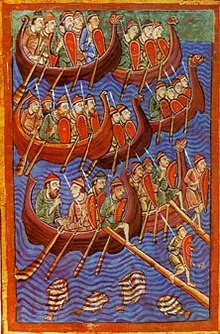
The most widely known and far reaching pirates in medieval Europe were the Vikings, warriors and looters from Scandinavia who raided mainly between the 8th and 12th centuries, during the Viking Age in the Early Middle Ages. They raided the coasts, rivers and inland cities of all Western Europe as far as Seville, attacked by the Norse in 844. Vikings even attacked coasts of North Africa and Italy. They also plundered all the coasts of the Baltic Sea, ascending the rivers of Eastern Europe as far as the Black Sea and Persia. The lack of centralized powers all over Europe during the Middle Ages favoured pirates all over the continent.[vague][citation needed]
In the Late Middle Ages, the Frisian pirates led by respectively Pier Gerlofs Donia and Wijerd Jelckama, fought against the troops of Charles V, Holy Roman Empire with some success, capturing as many as 28 ships in one battle earning Donia the title "Cross of the Dutchman" and making him one of the most famous and iconic pirates of the era.
Toward the end of the 9th century, Moor pirate havens were established along the coast of southern France and northern Italy.[11] In 846 Moor raiders sacked Rome and damaged the Vatican. In 911, the bishop of Narbonne was unable to return to France from Rome because the Moors from Fraxinet controlled all the passes in the Alps. Moor pirates operated out of the Balearic Islands in the 10th century. From 824 to 961 Arab pirates in the Emirate of Crete raided the entire Mediterranean. In the 14th century, raids by Moor pirates forced the Venetian Duke of Crete to ask Venice to keep its fleet on constant guard.[12]
After the Slavic invasions of the former Roman province of Dalmatia in the 5th and 6th centuries, a tribe called the Narentines revived the old Illyrian piratical habits and often raided the Adriatic Sea starting in the 7th century. By 642 they invaded southern Italy and assaulted Siponto. Their raids in the Adriatic increased rapidly, until the whole Sea was no longer safe for travel.
The Narentines took more liberties in their raiding quests while the Venetian Navy was abroad, as when it was campaigning in Sicilian waters in 827–882. As soon as the Venetian fleet would return to the Adriatic, the Narentines temporarily abandoned their habits again, even signing a Treaty in Venice and baptising their Slavic pagan leader into Christianity. In 834 or 835 they broke the treaty and again they raided Venetian traders returning from Benevento, and all of Venice's military attempts to punish them in 839 and 840 utterly failed. Later, they raided the Venetians more often, together with the Arabs. In 846, the Narentines broke through to Venice itself and raided its lagoon city of Caorle. In the middle of March 870 they kidnapped the Roman Bishop's emissaries that were returning from the Ecclesiastical Council in Constantinople. This caused a Byzantine military action against them that finally brought Christianity to them. After the Arab raids on the Adriatic coast circa 872 and the retreat of the Imperial Navy, the Narentines continued their raids of Venetian waters, causing new conflicts with the Italians in 887–888. The Venetians futilely continued to fight them throughout the 10th and 11th centuries.
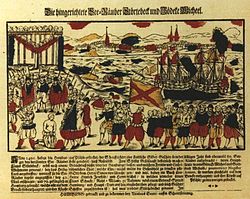
In 937, Irish pirates sided with the Scots, Vikings, Picts, and Welsh in their invasion of England. Athelstan drove them back.
The Slavic piracy in the Baltic Sea ended with the Danish conquest of the Rani stronghold of Arkona in 1168. In the 12th century the coasts of western Scandinavia were plundered by Curonians and Oeselians from the eastern coast of the Baltic Sea. In the 13th and 14th century, pirates threatened the Hanseatic routes and nearly brought sea trade to the brink of extinction. The Victual Brothers of Gotland were a companionship of privateers who later turned to piracy. Until about 1440, maritime trade in both the North Sea and the Baltic Sea was seriously in danger of attack by the pirates.
H. Thomas Milhorn mentions a certain Englishman named William Maurice, convicted of piracy in 1241, as the first person known to have been hanged, drawn and quartered,[13] which would indicate that the then-ruling King Henry III took an especially severe view of this crime.
The ushkuiniks were Novgorodian pirates who looted the cities on the Volga and Kama Rivers in the 14th century.
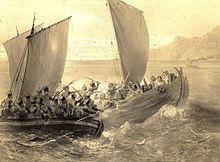
As early as Byzantine times, the Maniots (one of Greece's toughest populations) were known as pirates. The Maniots considered piracy as a legitimate response to the fact that their land was poor and it became their main source of income. The main victims of Maniot pirates were the Ottomans but the Maniots also targeted ships of European countries.
Zaporizhian Sich was a pirate republic in Europe from the 16th through to the 18th century. Situated in Cossack territory in the remote Steppe of Eastern Europe, it was populated with Ukrainian peasants that had run away from their feudal masters, outlaws of every sort, destitute gentry, run-away slaves from Turkish galleys, etc. The remoteness of the place and the rapids at the Dnepr river effectively guarded the place from invasions of vengeful powers. The main target of the inhabitants of Zaporizhian Sich who called themselves "Cossacks" were rich settlements at the Black Sea shores of Ottoman Empire and Crimean Khanate.[14] By 1615 and 1625, Zaporozhian Cossacks had even managed to raze townships on the outskirts of Istanbul, forcing the Ottoman Sultan to flee his palace.[15] Don Cossacks under Stenka Razin even ravaged the Persian coasts.[16]
Asia

In East Asia by the ninth century, populations centered mostly around merchant activities in coastal Shandong and Jiangsu provinces. Wealthy benefactors, including Jang Bogo established Silla Buddhist temples in the region. Jang Bogo had become incensed at the treatment of his fellow countrymen, who in the unstable milieu of late Tang often fell victim to coastal pirates or inland bandits. After returning to Silla around 825, and in possession of a formidable private fleet headquartered at Cheonghae (Wando), Jang Bogo petitioned the Silla king Heungdeok (r. 826–836) to establish a permanent maritime garrison to protect Silla merchant activities in the Yellow Sea. Heungdeok agreed and in 828 formally established the Cheonghae (??, "clear sea") Garrison at what is today Wando island off Korea's South Jeolla province. Heungdeok gave Jang an army of 10,000 men to establish and man the defensive works. The remnants of Cheonghae Garrison can still be seen on Jang islet just off Wando's southern coast. Jang's force, though nominally bequeathed by the Silla king, was effectively under his own control. Jang became arbiter of Yellow Sea commerce and navigation.[17]
From the 13th century, Wokou based in Japan made their debut in East Asia, initiating invasions that would persist for 300 years.

In South East Asia[18], piracy began with the retreating Mongol Yuan fleet after the betrayal by their Javanese allies (who, incidentally, would found the empire of Majapahit after the Mongols left). They preferred the junk, a ship using a more robust sail layout. Marooned navy officers, consisting mostly of Cantonese and Hokkien tribesmen, set up their small gangs near river estuaries, mainly to protect themselves. They recruited locals as common foot-soldiers known as 'lang' (lanun) to set up their fortresses. They survived by utilizing their well trained pugilists, as well as marine and navigation skills, mostly along Sumatran and Javanese estuaries. Their strength and ferocity coincided with the impending trade growth of the maritime silk and spice routes.
Starting in the 14th century, the Deccan (Southern Peninsular region of India) was divided into two entities: on the one side stood the Muslim Bahmani Sultanate and on the other stood the Hindu kings rallied around the Vijayanagara Empire. Continuous wars demanded frequent resupplies of fresh horses, which were imported through sea routes from Persia and Africa. This trade was subjected to frequent raids by thriving bands of pirates based in the coastal cities of Western India. One of such was Timoji, who operated off Anjadip Island both as a privateer (by seizing horse traders, that he rendered to the raja of Honavar) and as a pirate who attacked the Kerala merchant fleets that traded pepper with Gujarat.

During the 16th and 17th centuries, there was frequent European piracy against Mughal Indian merchants, especially those en route to Mecca for Hajj. The situation came to a head when the Portuguese attacked and captured the vessel Rahimi which belonged to Mariam Zamani the Mughal queen, which led to the Mughal seizure of the Portuguese town Daman.[19] In the 18th century, the famous Maratha privateer Kanhoji Angre ruled the seas between Mumbai and Goa.[20] The Marathas attacked British shipping and insisted that East India Company ships pay taxes if sailing through their waters.[21]
The Buginese sailors of South Sulawesi were infamous as pirates who used to range as far west as Singapore and as far north as the Philippines in search of targets for piracy.[22] The Orang laut pirates controlled shipping in the Straits of Malacca and the waters around Singapore,[23] and the Malay and Sea Dayak pirates preyed on maritime shipping in the waters between Singapore and Hong Kong from their haven in Borneo.[24] The Moro pirates of the southern Philippines harassed Spanish shipping and terrorized Christian Filipino settlements. David P. Forsythe wrote: "Of particular significance in Southeast Asia were the incursions of Moro raiders in the southern Philippines who may have captured around 2 million slaves in the first two centuries of Spanish rule after 1565."[25]
During the Qing period, Chinese pirate fleets grew increasingly large. The effects large-scale piracy had on the Chinese economy were immense. They preyed voraciously on China's junk trade, which flourished in Fujian and Guangdong and was a vital artery of Chinese commerce. Pirate fleets exercised hegemony over villages on the coast, collecting revenue by exacting tribute and running extortion rackets. In 1802, the menacing Zheng Yi inherited the fleet of his cousin, captain Zheng Qi, whose death provided Zheng Yi with considerably more influence in the world of piracy. Zheng Yi and his wife, Zheng Yi Sao (who would eventually inherit the leadership of his pirate confederacy) then formed a pirate coalition that, by 1804, consisted of over ten thousand men. Their military might alone was sufficient to combat the Qing navy. However, a combination of famine, Qing naval opposition, and internal rifts crippled piracy in China around the 1820s, and it has never again reached the same status.
Barbary corsairs
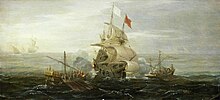
Pirates and privateers that operated from North African (the "Barbary Coast") ports of Algiers, Tunis, Tripoli and ports in Morocco were known as the Barbary corsairs. They preyed on shipping in the western Mediterranean Sea from the time of the Crusades, as well as on ships on their way to Asia around Africa until the early 19th century. The coastal villages and towns of Italy, Spain and Mediterranean islands were frequently attacked by them and long stretches of the Italian and Spanish coasts were almost completely abandoned by their inhabitants; after 1600 Barbary corsairs occasionally entered the Atlantic and struck as far north as Iceland. According to Robert Davis[26][27] between 1 million and 1.25 million Europeans were captured by Barbary corsairs and sold as slaves in North Africa and the Ottoman Empire between the 16th and 19th centuries. The most famous corsairs were the Ottoman Hayreddin and his older brother Oruç Reis (Redbeard), Turgut Reis (known as Dragut in the West), Kurtoglu (known as Curtogoli in the West), Kemal Reis, Salih Reis and Koca Murat Reis. A few Barbary corsairs, such as the Dutch Jan Janszoon and the English John Ward (Muslim name Yusuf Reis), were renegade European privateers who had converted to Islam.
At one stage, the pirate population of Madagascar numbered close to 1000.[28] Île Sainte-Marie became a popular base for pirates throughout the 17th and 18th centuries. The most famous pirate utopia is that of the probably fictional Captain Misson and his pirate crew, who allegedly founded the free colony of Libertatia in northern Madagascar in the late 17th century, until it was destroyed in a surprise attack by the island natives in 1694.[29]
Golden age of piracy in the Caribbean
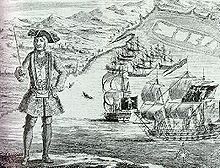
The classic era of piracy was in the Caribbean, from around 1650 up until the mid-1720s.[30] By 1650, France, England and the United Provinces began to develop their colonial empires. This involved considerable seaborne trade, and a general economic improvement: there was money to be made—or stolen—and much of it traveled by ship.
French buccaneers were established on northern Hispaniola as early as 1625,[31] but lived at first mostly as hunters rather than robbers; their transition to full-time piracy was gradual and motivated in part by Spanish efforts to wipe out both the buccaneers and the prey animals on which they depended. The buccaneers' migration from Hispaniola's mainland to the more defensible offshore island of Tortuga limited their resources and accelerated their piratical raids. According to Alexandre Exquemelin, a buccaneer and historian who remains a major source on this period, the Tortuga buccaneer Pierre Le Grand pioneered the settlers' attacks on galleons making the return voyage to Spain.
The growth of buccaneering on Tortuga was augmented by the English capture of Jamaica from Spain in 1655. The early English governors of Jamaica freely granted letters of marque to Tortuga buccaneers and to their own countrymen, while the growth of Port Royal provided these raiders with a far more profitable and enjoyable place to sell their booty. In the 1660s, the new French governor of Tortuga, Bertrand d'Ogeron, similarly provided privateering commissions both to his own colonists and to English cutthroats from Port Royal. These conditions brought Caribbean buccaneering to its zenith.

A new phase of piracy began in the 1690s as English pirates began to look beyond the Caribbean for treasure. The fall of Britain's Stuart kings had restored the traditional enmity between Britain and France, thus ending the profitable collaboration between English Jamaica and French Tortuga. The devastation of Port Royal by an earthquake in 1692 further reduced the Caribbean's attractions by destroying the pirates' chief market for fenced plunder.[32] Caribbean colonial governors began to discard the traditional policy of "no peace beyond the Line," under which it was understood that war would continue (and thus letters of marque would be granted) in the Caribbean regardless of peace treaties signed in Europe; henceforth, commissions would be granted only in wartime, and their limitations would be strictly enforced. Furthermore, much of the Spanish Main had simply been exhausted; Maracaibo alone had been sacked three times between 1667 and 1678,[33] while Río de la Hacha had been raided five times and Tolú eight.[34]
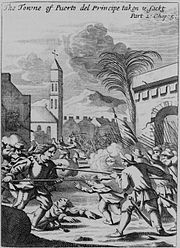
At the same time, England's less favored colonies, including Bermuda, New York, and Rhode Island, had become cash-starved by the Navigation Acts, which restricted trade with foreign ships. Merchants and governors eager for coin were willing to overlook and even underwrite pirate voyages; one colonial official defended a pirate because he thought it "very harsh to hang people that brings in gold to these provinces."[35] Although some of these pirates operating out of New England and the Middle Colonies targeted Spain's remoter Pacific coast colonies well into the 1690s and beyond, the Indian Ocean was a richer and more tempting target. India's economic output was large during this time, especially in high-value luxury goods like silk and calico which made ideal pirate booty;[36] at the same time, no powerful navies plied the Indian Ocean, leaving both local shipping and the various East India companies' vessels vulnerable to attack. This set the stage for the famous pirates, Thomas Tew, Henry Every, Robert Culliford and (although his guilt remains controversial) William Kidd.
Between 1713 and 1714, a succession of peace treaties was signed which ended the War of the Spanish Succession. With the end of this conflict, thousands of seamen, including Britain's paramilitary privateers, were relieved of military duty. The result was a large number of trained, idle sailors at a time when the cross-Atlantic colonial shipping trade was beginning to boom. In addition, Europeans who had been pushed by unemployment to become sailors and soldiers involved in slaving were often enthusiastic to abandon that profession and turn to pirating, giving pirate captains for many years a constant pool of trained European recruits to be found in west African waters and coasts.
In 1715, pirates launched a major raid on Spanish divers trying to recover gold from a sunken treasure galleon near Florida. The nucleus of the pirate force was a group of English ex-privateers, all of whom would soon be enshrined in infamy: Henry Jennings, Charles Vane, Samuel Bellamy, and Edward England. The attack was successful, but contrary to their expectations, the governor of Jamaica refused to allow Jennings and their cohorts to spend their loot on his island. With Kingston and the declining Port Royal closed to them, Jennings and his comrades founded a new pirate base at Nassau, on the island of New Providence in the Bahamas, which had been abandoned during the war. Until the arrival of governor Woodes Rogers three years later, Nassau would be home for these pirates and their many recruits.
Shipping traffic between Africa, the Caribbean, and Europe began to soar in the 18th century, a model that was known as triangular trade, and was a rich target for piracy. Trade ships sailed from Europe to the African coast, trading manufactured goods and weapons for slaves. The traders would then sail to the Caribbean to sell the slaves, and return to Europe with goods such as sugar, tobacco and cocoa. Another triangular trade saw ships carry raw materials, preserved cod, and rum to Europe, where a portion of the cargo would be sold for manufactured goods, which (along with the remainder of the original load) were transported to the Caribbean, where they were exchanged for sugar and molasses, which (with some manufactured articles) were borne to New England. Ships in the triangular trade made money at each stop.[37]

As part of the peace settlement of the War of the Spanish succession, Britain obtained the asiento, a Spanish government contract, to supply slaves to Spain's new world colonies, providing British traders and smugglers more access to the traditionally closed Spanish markets in America. This arrangement also contributed heavily to the spread of piracy across the western Atlantic at this time. Shipping to the colonies boomed simultaneously with the flood of skilled mariners after the war. Merchant shippers used the surplus of sailors' labor to drive wages down, cutting corners to maximize their profits, and creating unsavory conditions aboard their vessels. Merchant sailors suffered from mortality rates as high or higher than the slaves being transported (Rediker, 2004). Living conditions were so poor that many sailors began to prefer a freer existence as a pirate. The increased volume of shipping traffic also could sustain a large body of brigands preying upon it. Among the most infamous Caribbean pirates of the time, was Edward Teach or Blackbeard, Calico Jack Rackham, Henry Morgan and Bartholomew Roberts. Most of these pirates were eventually hunted down by the Royal Navy and killed or captured; several battles were fought between the brigands and the colonial powers on both land and sea.
Piracy in the Caribbean declined for the next several decades after 1730, but by the 1810s many pirates roamed the waters though they were not as bold or successful as their predecessors. The most successful pirates of the era were Jean Lafitte and Roberto Cofresi. Lafitte is considered by many to be the last buccaneer due to his army of pirates and fleet of pirate ships which held bases in and around the Gulf of Mexico. Lafitte and his men participated in the War of 1812 battle of New Orleans. Cofresi's base was in Puerto Rico where he was considered a type of Robin Hood by many Puerto Ricans.
North America
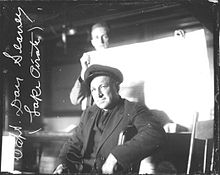
River piracy, in late 18th-mid-19th century America, was primarily concentrated along the Ohio River and Mississippi River valleys. In 1803, at Tower Rock, the U.S. Army dragoons, possibly, from the frontier army post up river at Fort Kaskaskia, on the Illinois side opposite St. Louis, raided and drove out the river pirates.
Stack Island was also associated with river pirates and counterfeiters in the late 1790s. In 1809, the last major river pirate activity took place, on the Upper Mississippi River, and river piracy in this area came to an abrupt end, when a group of flatboatmen raided the island, wiping out the river pirates. From 1790–1834, Cave-In-Rock was the principal outlaw lair and headquarters of river pirate activity in the Ohio River region, from which Samuel Mason led a gang of river pirates on the Ohio River.
River piracy continued on the lower Mississippi River, from the early 1800s to the mid-1830s, declining as a result of direct military action and local law enforcement and regulator-vigilante groups that uprooted and swept out pockets of outlaw resistance.
Great Lakes piracy occurred, from 1900–1930, on Lake Michigan, through the exploits of "Roaring" Dan Seavey.
Suppression of piracy
Caribbean

The elimination of piracy from European waters expanded to the Caribbean in the 18th century, West Africa and North America by the 1710s and by the 1720s even the Indian Ocean was a difficult location for pirates to operate.
England began to strongly turn against piracy at the turn of the 18th century, as it was increasingly damaging to the country's economic and commercial prospects in the region. The Piracy Act of 1698 for the "more effectual suppression of Piracy" [38] made it easier to capture, try and convict pirates by lawfully enabling acts of piracy to be “examined, inquired of, tried, heard and determined, and adjudged in any place at sea, or upon the land, in any of his Majesty’s islands, plantations, colonies, dominions, forts, or factories.” This effectively enabled admirals to hold a court session to hear the trials of pirates in any place they deemed necessary, rather than requiring that the trial be held in England. Commissioners of these vice-admiralty courts were also vested with “full power and authority” to issue warrants, summon the necessary witnesses, and “to do all thing necessary for the hearing and final determination of any case of piracy, robbery, or felony.” These new and faster trials provided no legal representation for the pirates; and ultimately led in this era to the execution of 600 pirates, which represented approximately 10 percent of the pirates active at the time in the Caribbean region.[39]Being an accessory to piracy was also criminalised under the statute.

Piracy saw a brief resurgence between the end of the War of the Spanish Succession in 1713 and around 1720, as many unemployed seafarers took to piracy as a way to make ends meet when a surplus of sailors after the war led to a decline in wages and working conditions. At the same time, one of the terms of the Treaty of Utrecht that ended the war gave to Great Britain's Royal African Company and other British slavers a thirty-year asiento, or contract, to furnish African slaves to the Spanish colonies, providing British merchants and smugglers potential inroads into the traditionally closed Spanish markets in America and leading to an economic revival for the whole region. This revived Caribbean trade provided rich new pickings for a wave of piracy. Also contributing to the increase of Caribbean piracy at this time was Spain's breakup of the English logwood settlement at Campeche and the attractions of a freshly sunken silver fleet off the southern Bahamas in 1715. Fears over the rising levels of crime and piracy, political discontent, concern over crowd behaviour at public punishments, and an increased determination by parliament to suppress piracy, resulted in the Piracy Act of 1717 and of 1721. These established a seven-year penal transportation to North America as a possible punishment for those convicted of lesser felonies, or as a possible sentence that capital punishment might be commuted to by royal pardon.
After 1720, piracy in the classic sense became extremely rare as increasingly effective anti-piracy measures were taken by the Royal Navy making it impossible for any pirate to pursue an effective career for long. By 1718, the British Royal Navy had approximately 124 vessels and 214 by 1815; a big increase from the two vessels England had possessed in 1670.[39] British Royal Navy warships tirelessly hunted down pirate vessels, and almost always won these engagements.

Many pirates did not surrender and were killed at the point of capture; notorious pirate Edward Teach, or "Blackbeard", was hunted down by Lieutenant Robert Maynard at Ocracoke Inlet off the coast of North Carolina on 22 November 1718 and killed. Captain Chaloner Ogle of the HMS Swallow cornered Bartholomew Roberts in 1722 at Cape Lopez, and a fatal broadside from the Swallow killed the pirate captain instantly. Roberts' death shocked the pirate world, as well as the Royal Navy. The local merchants and civilians had thought him invincible, and some considered him a hero.[citation needed] Roberts' death was seen by many historians as the end of the Golden Age of Piracy. Also crucial to the end of this era of piracy was the loss of the pirates' last Caribbean safe haven at Nassau.
In the early 19th century, piracy along the East and Gulf Coasts of North America as well as in the Caribbean increased again. Jean Lafitte was just one of hundreds of pirates operating in American and Caribbean waters between the years of 1820 and 1835. The United States Navy repeatedly engaged pirates in the Caribbean, Gulf of Mexico and in the Mediterranean. Roberto Cofresi was defeated by the schooner USS Grampus and captured in 1825. The United States landed shore parties on several islands in the Caribbean in pursuit of pirates; Cuba was a major haven. By the 1830s piracy had died out again, and the navies of the region focused on the slave trade.
About the time of the Mexican-American War in 1846, the United States Navy had grown strong and numerous enough to eliminate the pirate threat in the West Indies. By the 1830s, ships had begun to convert to steam propulsion, so the Age of Sail and the classical idea of pirates in the Caribbean ended. Privateering, similar to piracy, continued as an asset in war for a few more decades and proved to be of some importance during the naval campaigns of the American Civil War.
Privateering would remain a tool of European states until the mid-19th century's Declaration of Paris. But letters of marque were given out much more sparingly by governments and were terminated as soon as conflicts ended. The idea of "no peace beyond the Line" was a relic that had no meaning by the more settled late 18th and early 19th centuries.
Barbary pirates

Piracy off the Barbary coast was often assisted by competition among European powers in the 17th century. France encouraged the corsairs against Spain, and later Britain and Holland supported them against France. However, by the second half of the 17th century the greater European naval powers began to initiate reprisals to intimidate the Barbary States into making peace with them. The most successful of the Christian states in dealing with the corsair threat was England.[citation needed] From the 1630s onwards England had signed peace treaties with the Barbary States on various occasions, but invariably breaches of these agreements led to renewed wars. A particular bone of contention was the tendency of foreign ships to pose as English to avoid attack. However, growing English naval power and increasingly persistent operations against the corsairs proved increasingly costly for the Barbary States. During the reign of Charles II a series of English expeditions won victories over raiding squadrons and mounted attacks on their home ports which permanently ended the Barbary threat to English shipping. In 1675 a bombardment from a Royal Navy squadron led by Sir John Narborough and further defeats at the hands of a squadron under Arthur Herbert negotiated a lasting peace (until 1816) with Tunis and Tripoli.
France, which had recently emerged as a leading naval power, achieved comparable success soon afterwards, with bombardments of Algiers in 1682, 1683 and 1688 securing a lasting peace, while Tripoli was similarly coerced in 1686. In 1783 and 1784 the Spaniards also bombarded Algiers in an effort to stem the piracy. The second time, Admiral Barceló damaged the city so severely that the Algerian Dey asked Spain to negotiate a peace treaty and from then on Spanish vessels and coasts were safe for several years.
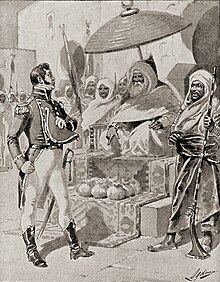
Until the American Declaration of Independence in 1776, British treaties with the North African states protected American ships from the Barbary corsairs. Morocco, which in 1777 was the first independent nation to publicly recognize the United States, became in 1784 the first Barbary power to seize an American vessel after independence. While the United States managed to secure peace treaties, these obliged it to pay tribute for protection from attack. Payments in ransom and tribute to the Barbary states amounted to 20% of United States government annual expenditures in 1800,[40] leading to the Barbary Wars that ended the payment of tribute. However, Algiers broke the 1805 peace treaty after only two years, and subsequently refused to implement the 1815 treaty until compelled to do so by Britain in 1816.
In 1815, the sacking of Palma on the island of Sardinia by a Tunisian squadron, which carried off 158 inhabitants, roused widespread indignation. Britain had by this time banned the slave trade and was seeking to induce other countries to do likewise. This led to complaints from states which were still vulnerable to the corsairs that Britain's enthusiasm for ending the trade in African slaves did not extend to stopping the enslavement of Europeans and Americans by the Barbary States.
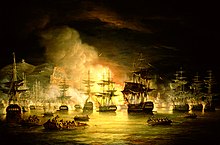
In order to neutralise this objection and further the anti-slavery campaign, in 1816 Lord Exmouth was sent to secure new concessions from Tripoli, Tunis, and Algiers, including a pledge to treat Christian captives in any future conflict as prisoners of war rather than slaves and the imposition of peace between Algiers and the kingdoms of Sardinia and Sicily. On his first visit he negotiated satisfactory treaties and sailed for home. While he was negotiating, a number of Sardinian fishermen who had settled at Bona on the Tunisian coast were brutally treated without his knowledge. As Sardinians they were technically under British protection and the government sent Exmouth back to secure reparation. On August 17, in combination with a Dutch squadron under Admiral Van de Capellen, he bombarded Algiers. Both Algiers and Tunis made fresh concessions as a result.
However, securing uniform compliance with a total prohibition of slave-raiding, which was traditionally of central importance to the North African economy, presented difficulties beyond those faced in ending attacks on ships of individual nations, which had left slavers able to continue their accustomed way of life by preying on less well-protected peoples. Algiers subsequently renewed its slave-raiding, though on a smaller scale. Measures to be taken against the city's government were discussed at the Congress of Aix-la-Chapelle in 1818. In 1820 another British fleet under Admiral Sir Harry Neal again bombarded Algiers. Corsair activity based in Algiers did not entirely cease until its conquest by France in 1830.[41]
China and Red Sea
In the 1840s and 1850s, United States Navy and Royal Navy forces campaigned together against Chinese pirates. Several notable battles were fought though pirate junks continued operating off China for years more. However, some British and American individual citizens also volunteered to serve with Chinese pirates to fight against European forces. The British offered rewards for the capture of westerners serving with Chinese pirates. During the Second Opium War and the Taiping Rebellion, piratical junks were again destroyed in large numbers by British naval forces but ultimately it wasn't until the 1860s and 1870s that fleets of pirate junks ceased to exist.
The southern coast of the Persian Gulf was known as the Pirate Coast from where raiders constantly harassed foreign shipping. Early British expeditions to protect the Indian Ocean trade from raiders at Ras al-Khaimah led to campaigns against that headquarters and other harbours along the coast in 1819.[42]
Popular image
In the popular modern imagination, pirates of the classical period were rebellious, clever teams who operated outside the restricting bureaucracy of modern life. Pirates were also depicted as always raising their Jolly Roger flag when preparing to hijack a vessel. The Jolly Roger is the traditional name for the flags of mainly English pirates and a symbol for piracy that has been adopted by film-makers and toy manufacturers.
Various claims and speculation about their overall image, attire, fashion, dress code, etc. have been made and contributed to their fanciful mystery and lore. Including, for example, men getting their ear pierced was popular with pirates; the value of the earring was meant to pay for their burial if they were lost at sea and their body washed ashore.[citation needed]
Pirate democracy

Unlike traditional Western societies of the time, many Caribbean pirate crews of European descent operated as limited democracies. Pirate communities were some of the first to instate a system of checks and balances similar to the one used by the present-day United States and many other countries. The first record of such a government aboard a pirate sloop dates to the 17th century.[43]
Both the captain and the quartermaster were elected by the crew. They, in turn, appointed the ship's other officers. The captain of a pirate ship was often a fierce fighter in whom the men could place their trust, rather than a more traditional authority figure sanctioned by an elite. However, when not in battle, the quartermaster usually had the real authority. Many groups of pirates shared in whatever they seized. Pirates injured in battle thus might be afforded special compensation similar to medical or disability insurance.
There are contemporary records that many pirates placed a portion of any captured money into a central fund that was used to compensate the injuries sustained by the crew. Lists show standardised payments of 600 pieces of eight ($156,000 in modern currency) for the loss of a leg down to 100 pieces ($26,800) for loss of an eye. Often all of these terms were agreed upon and written down by the pirates, but these articles could also be used as incriminating proof that they were outlaws.
Sunken pirate ships
To date only a single identifiable pirate shipwreck has been discovered, the Whydah Gally, a former slave ship seized on it’s maiden voyage from Africa by the pirate captain "Black Sam" Bellamy. Since 2007 the Wydah collection has been touring as part of the exhibit "Real Pirates" sponsored by National Geographic.[44]
Treasure
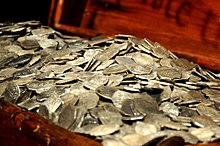
Even though pirates raided many ships, few, if any, buried their treasure. Often, the "treasure" that was stolen was food, water, alcohol, weapons, or clothing. Other things they stole were household items like bits of soap and gear like rope and anchors, or sometimes they would keep the ship they captured (either to sell off or keep because it was better than their ship). Such items were likely to be needed immediately, rather than saved for future trade. For this reason, there was no reason for the pirates to bury these goods. Pirates tended to kill few people aboard the ships they captured; usually they would kill no one if the ship surrendered because, if it became known that pirates took no prisoners, their victims would fight to the last breath and make victory both very difficult and costly in lives. In contrast, ships would quickly surrender if they knew they would be spared. In one well-documented case 300 heavily armed soldiers on a ship attacked by Thomas Tew surrendered after a brief battle with none of Tew's 40-man crew being injured.[45]
Other noteworthy speculation involving pirates and their perceived high-importance and priorities toward that of fortune-hunting and traditional treasure exist; such as the iconic image of pirates with ear piercing, was as a result of being a practical purpose among and therefore popular with pirates. The belief being the value of the earring was meant to pay for their burial if they were lost at sea and their body washed ashore.[citation needed]
Rewards
Pirates had a system of hierarchy on board their ships determining how captured money was distributed. However, pirates were more "egalitarian" than any other area of employment at the time. In fact pirate quartermasters were a counterbalance to the captain and had the power to veto his orders. The majority of plunder was in the form of cargo and ship's equipment with medicines the most highly prized. A vessel's doctor's chest would be worth anywhere from £300 to £400, or around $470,000 in today's values. Jewels were common plunder but not popular as they were hard to sell, and pirates, unlike the public of today, had little concept of their value. There is one case recorded where a pirate was given a large diamond worth a great deal more than the value of the handful of small diamonds given his crewmates as a share. He felt cheated and had it broken up to match what they received.[46]
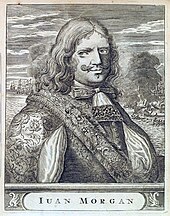
Spanish pieces of eight minted in Mexico or Seville were the standard trade currency in the American colonies. However, every colony still used the monetary units of pounds, shillings and pence for bookkeeping while Spanish, German, French and Portuguese money were all standard mediums of exchange as British law prohibited the export of British silver coinage. Until the exchange rates were standardised in the late 18th century each colony legislated its own different exchange rates. In England, 1 piece of eight was worth 4s 3d while it was worth 8s in New York, 7s 6d in Pennsylvania and 6s 8d in Virginia. One 18th-century English shilling was worth around $58 in modern currency so a piece of eight could be worth anywhere from $246 to $465. As such, the value of pirate plunder could vary considerably depending on who recorded it and where.[47][48]
Ordinary seamen received a part of the plunder at the captain's discretion but usually a single share. On average, a pirate could expect the equivalent of a year's wages as his share from each ship captured while the crew of the most successful pirates would often each receive a share valued at around £1,000 ($1.17 million) at least once in their career.[46] One of the larger amounts taken from a single ship was that by captain Thomas Tew from an Indian merchantman in 1692. Each ordinary seaman on his ship received a share worth £3,000 ($3.5 million) with officers receiving proportionally larger amounts as per the agreed shares with Tew himself receiving 2½ shares. It is known there were actions with multiple ships captured where a single share was worth almost double this.[46][49]
By contrast, an ordinary seamen in the Royal Navy received 19s per month to be paid in a lump sum at the end of a tour of duty which was around half the rate paid in the Merchant Navy. However, corrupt officers would often "tax" their crews' wage to supplement their own and the Royal Navy of the day was infamous for its reluctance to pay. From this wage, 6d per month was deducted for the maintenance of Greenwich Hospital with similar amounts deducted for the Chatham Chest, the chaplain and surgeon. Six months' pay was withheld to discourage desertion. That this was insufficient incentive is revealed in a report on proposed changes to the RN Admiral Nelson wrote in 1803; he noted that since 1793 more than 42,000 sailors had deserted. Roughly half of all RN crews were pressganged and these not only received lower wages than volunteers but were shackled while the vessel was docked and were never permitted to go ashore until released from service.[50][51]
Although the Royal Navy suffered from many morale issues, it answered the question of prize money via the 'Cruizers and Convoys' Act of 1708 which handed over the share previously gained by the Crown to the captors of the ship. Technically it was still possible for the Crown to get the money or a portion of it but this rarely happened. The process of condemnation of a captured vessel and its cargo and men was given to the High Court of the Admiralty and this was the process which remained in force with minor changes throughout the Revolutionary and Napoleonic Wars.
| Rank | Pre 1808 | Post 1808 |
|---|---|---|
| Captain | 3/8 | 2/8 |
| Admiral of fleet | 1/8 | 1/8 |
| Sailing Master & Lieutenants & Captain of Marines |
1/8 | 1/8 |
| Warrant Officers | 1/8 | 1/8 |
| Wardroom Warrant officers & Petty Officers |
1/8 | 1/8 |
| Gunners, Sailors | 1/8 | 2/8 |

Even the flag officer's share was not quite straightforward; he would only get the full one-eighth if he had no junior flag officer beneath him. If this was the case then he would get a third share. If he had more than one then he would take one half while the rest was shared out equally.
There was a great deal of money to be made in this way. The record breaker was the capture of the Spanish frigate the Hermione, which was carrying treasure in 1762. The value of this was so great that each individual seaman netted £485 ($1.4 million in 2008 dollars).[52] The two captains responsible, Evans and Pownall, received £65,000 each ($188.4 million). In January 1807 the frigate Caroline took the Spanish San Rafael which brought in £52,000 for her captain, Peter Rainier (who had been only a Midshipman some thirteen months before). All through the wars there are examples of this kind of luck falling on captains. Another famous 'capture' was that of the Spanish frigates Thetis and Santa Brigada which were loaded with gold specie. They were taken by four British frigates who shared the money, each captain receiving £40,730. Each lieutenant got £5,091, the Warrant Officer group, £2,468, the midshipmen £791 and the individual seamen £182.
It should also be noted that it was usually only the frigates which took prizes; the ships of the line were far too ponderous to be able to chase and capture the smaller ships which generally carried treasure. Nelson always bemoaned that he had done badly out of prize money and even as a flag officer received little. This was not that he had a bad command of captains but rather that British mastery of the seas was so complete that few enemy ships dared to sail.[53]
| Rank | Bartholomew Roberts | George Lowther | William Phillips | Privateer (Sir William Monson) |
Royal Navy (per month) |
|---|---|---|---|---|---|
| Captain | 2 shares | 2 shares | 1.5 shares | 10 shares | £8, 8s |
| Master | 1.5 shares | 1.5 shares | 1.25 shares | 7 or 8 shares | £4 |
| Boatswain | 1.5 shares | 1.25 shares | 1.25 shares | 5 shares | £2 |
| Gunner | 1.5 shares | 1.25 shares | 1.25 shares | 5 shares | £2 |
| Quartermaster | 2 shares | 4 shares | £1, 6s | ||
| Carpenter | 1.25 shares | 5 shares | £2 | ||
| Mate | 1.25 shares | 5 shares | £2, 2s | ||
| Doctor | 1.25 shares | 5 shares | £5 +2d per man aboard | ||
| "Other Officers" | 1.25 shares | various rates | various rates | ||
| Able Seamen (2 yrs experience) Ordinary Seamen (some exp) Landsmen (pressganged) |
1 share |
1 share |
1 share |
22s 19s 11s |
Punishment
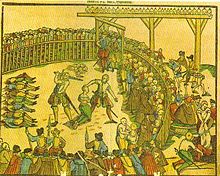
During the 17th and 18th centuries, once pirates were caught, justice was meted out in a summary fashion, and many ended their lives by "dancing the hempen jig", or hanging at the end of a rope. Public execution was a form of entertainment at the time, and people came out to watch them as they would to a sporting event today. Newspapers were glad to report every detail, such as recording the condemned men's last words, the prayers said by the priests for their immortal souls, and their final agonising moments on the gallows. In England most of these executions took place at Execution Dock on the River Thames in London.
In the cases of more famous prisoners, usually captains, their punishments extended beyond death. Their bodies were enclosed in iron cages (gibbet) (for which they were measured before their execution) and left to swing in the air until the flesh rotted off them- a process that could take as long as two years. The bodies of captains such as William "Captain" Kidd, Charles Vane, William Fly, and Jack Rackham ("Calico Jack") were all treated this way.[54]
Within the Pirate community, however, 'Justice' was swift and decisive. 'Cut-throat prudence demanded nothing less. Famously, keelhauling was a popular method for relatively minor crimes, while 'abandonment' on an island was not unknown either. Indeed, 'Walking the plank' is now generally thought to refer to 'walking the last mile' down the gangplank to the miscreants new 'Home'.[citation needed]
Privateers

A privateer or corsair used similar methods to a pirate, but acted while in possession of a commission or letter of marque and reprisal from a government or monarch authorizing the capture of merchant ships belonging to an enemy nation. For example, the United States Constitution of 1787 specifically authorized Congress to issue letters of marque and reprisal. The letter of marque and reprisal was recognized by international convention and meant that a privateer could not technically be charged with piracy while attacking the targets named in his commission. This nicety of law did not always save the individuals concerned, however, as whether one was considered a pirate or a legally operating privateer often depended on whose custody the individual found himself in—that of the country that had issued the commission, or that of the object of attack. Spanish authorities were known to execute foreign privateers with their letters of marque hung around their necks to emphasize Spain's rejection of such defenses. Furthermore, many privateers exceeded the bounds of their letters of marque by attacking nations with which their sovereign was at peace (Thomas Tew and William Kidd are notable alleged examples), and thus made themselves liable to conviction for piracy. However, a letter of marque did provide some cover for such pirates, as plunder seized from neutral or friendly shipping could be passed off later as taken from enemy merchants.
The famous Barbary Corsairs of the Mediterranean, authorized by the Ottoman Empire, were privateers, as were the Maltese Corsairs, who were authorized by the Knights of St. John, and the Dunkirkers in the service of the Spanish Empire. In the years 1626–1634 alone, the Dunkirk privateers captured 1,499 ships, and sank another 336.[55] From 1609 to 1616, England lost 466 merchant ships to Barbary pirates, and 160 British ships were captured by Algerians between 1677 and 1680.[56] One famous privateer was Sir Francis Drake. His patron was Queen Elizabeth I, and their relationship ultimately proved to be quite profitable for England.[57]
Privateers constituted a large proportion of the total military force at sea during the 17th and 18th centuries. During the Nine Years War, the French adopted a policy of strongly encouraging privateers (French corsairs), including the famous Jean Bart, to attack English and Dutch shipping. England lost roughly 4,000 merchant ships during the war.[58] In the following War of Spanish Succession, privateer attacks continued, Britain losing 3,250 merchant ships.[59] During the War of Austrian Succession, Britain lost 3,238 merchant ships and France lost 3,434 merchant ships to the British.[58]
During King George's War, approximately 36,000 Americans served aboard privateers at one time or another.[58] During the American Revolution, about 55,000 American seamen served aboard the privateers.[60] The American privateers had almost 1,700 ships, and they captured 2,283 enemy ships.[61] Between the end of the Revolutionary War and 1812, less than 30 years, Britain, France, Naples, the Barbary States, Spain, and the Netherlands seized approximately 2,500 American ships.[62] Payments in ransom and tribute to the Barbary states amounted to 20% of United States government annual revenues in 1800.[63] Throughout the American Civil War, Confederate privateers successfully harassed Union merchant ships.[64]
Privateering lost international sanction under the Declaration of Paris in 1856.
Modern age
| Part of a series on |
| Terrorism |
|---|
Overview
Seaborne piracy against transport vessels remains a significant issue (with estimated worldwide losses of US$13 to $16 billion per year),[65][66] particularly in the waters between the Red Sea and Indian Ocean, off the Somali coast, and also in the Strait of Malacca and Singapore, which are used by over 50,000 commercial ships a year. In the late 2000s,[67] the emergence of piracy off the coast of Somalia spurred a multi-national effort led by the United States to patrol the waters near the Horn of Africa. In 2011, Brazil also created an anti-piracy unit on the Amazon river.[68]
In recent years, shipping companies claimed that their vessels suffer from regular pirate attacks on the Serbian and Romanian stretches of the international Danube river, i.e. inside the European Union's territory, starting from at least 2011.[69][70][71]
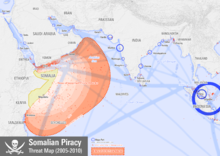
Modern pirates favor small boats and taking advantage of the small number of crew members on modern cargo vessels. They also use large vessels to supply the smaller attack/boarding vessels. Modern pirates can be successful because a large amount of international commerce occurs via shipping. Major shipping routes take cargo ships through narrow bodies of water such as the Gulf of Aden and the Strait of Malacca making them vulnerable to be overtaken and boarded by small motorboats.[72][73] Other active areas include the South China Sea and the Niger Delta. As usage increases, many of these ships have to lower cruising speeds to allow for navigation and traffic control, making them prime targets for piracy.
Also, pirates often operate in regions of developing or struggling countries with smaller navies and large trade routes. Pirates sometimes evade capture by sailing into waters controlled by their pursuer's enemies. With the end of the Cold War, navies have decreased size and patrol, and trade has increased, making organized piracy far easier. Modern pirates are sometimes linked with organized-crime syndicates, but often are parts of small individual groups.
The International Maritime Bureau (IMB) maintains statistics regarding pirate attacks dating back to 1995. Their records indicate hostage-taking overwhelmingly dominates the types of violence against seafarers. For example in 2006, there were 239 attacks, 77 crew members were kidnapped and 188 taken hostage but only 15 of the pirate attacks resulted in murder.[74] In 2007 the attacks rose by 10% to 263 attacks. There was a 35% increase on reported attacks involving guns. Crew members that were injured numbered 64 compared to just 17 in 2006.[75] That number does not include instances of hostage taking and kidnapping where the victims were not injured.

The number of attacks from January to September 2009 had surpassed the previous year's total due to the increased pirate attacks in the Gulf of Aden and off Somalia. Between January and September the number of attacks rose to 306 from 293. The pirates boarded the vessels in 114 cases and hijacked 34 of them so far in 2009. Gun use in pirate attacks has gone up to 176 cases from 76 last year.[76]
Rather than cargo, modern pirates have targeted the personal belongings of the crew and the contents of the ship's safe, which potentially contains large amounts of cash needed for payroll and port fees. In other cases, the pirates force the crew off the ship and then sail it to a port to be repainted and given a new identity through false papers purchased from corrupt or complicit officials.[77]
Modern piracy can also take place in conditions of political unrest. For example, following the U.S. withdrawal from Vietnam, Thai piracy was aimed at the many Vietnamese who took to boats to escape. Further, following the disintegration of the government of Somalia, warlords in the region have attacked ships delivering UN food aid.[78]

Environmental action groups such as Sea Shepherd Conservation Society have been accused of engaging in piracy and terrorism, when they ram and throw butyric acid on the decks of ships engaged in commercial fishing, shark poaching and finning, seal hunting, and whaling. In two instances, they boarded a Japanese whaling vessel.[79][80]
The attack against the German built cruise ship the Seabourn Spirit offshore of Somalia in November 2005 is an example of the sophisticated pirates mariners face. The pirates carried out their attack more than 100 miles (160 km) offshore with speedboats launched from a larger mother ship. The attackers were armed with automatic firearms and an RPG.[81]
Since 2008, Somali pirates centered in the Gulf of Aden made about $120 million annually, reportedly costing the shipping industry between $900 million and $3.3 billion per year.[82] By September 2012, the heyday of piracy in the Indian Ocean was reportedly over. Backers were now reportedly reluctant to finance pirate expeditions due to the low rate of success, and pirates were no longer able to reimburse their creditors.[83] According to the International Maritime Bureau, pirate attacks had by October 2012 dropped to a six-year low.[84] Only five ships were captured by the end of the year, representing a decrease from 25 in 2011 and 27 in 2010,[85] with only 1 ship attacked in the third quarter compared to 36 during the same period in 2011.[84] However, pirate incidents off on the West African seaboard increased to 34 from 30 the previous year, and attacks off the coast of Indonesia rose from 2011's total of 46 to 51.[84]
Many nations forbid ships to enter their territorial waters or ports if the crew of the ships are armed, in an effort to restrict possible piracy.[86] Shipping companies sometimes hire private armed security guards.
Modern definitions of piracy include the following acts:
- Boarding
- Extortion
- Hostage taking
- Kidnapping of people for ransom
- Murder
- Robbery
- Sabotage resulting in the ship subsequently sinking
- Seizure of items or the ship
- Shipwrecking done intentionally to a ship
For the United States, piracy is one of the offenses against which Congress is delegated power to enact penal legislation by the Constitution of the United States, along with treason and offenses against the law of nations. Treason is generally making war against one's own countrymen, and violations of the law of nations can include unjust war among other nationals or by governments against their own people.
In modern times, ships and airplanes are hijacked for political reasons as well. The perpetrators of these acts could be described as pirates (for instance, the French for plane hijacker is pirate de l'air, literally air pirate), but in English are usually termed hijackers. An example is the hijacking of the Italian civilian passenger ship Achille Lauro in 1985, which is generally regarded as an act of piracy.
Modern pirates also use a great deal of technology. It has been reported that crimes of piracy have involved the use of mobile phones, satellite phones, GPS, Sonar systems, modern speedboats, assault rifles, shotguns, pistols, mounted machine guns, and even RPGs and grenade launchers.
Legal principles and considerations
This article's tone or style may not reflect the encyclopedic tone used on Wikipedia. (June 2013) |
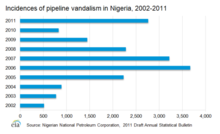
Under a principle of international law known as the "universality principle", a government may "exercise jurisdiction over conduct outside its territory if that conduct is universally dangerous to states and their nationals."[87] The rationale behind the universality principle is that states will punish certain acts "wherever they may occur as a means of protecting the global community as a whole, even absent a link between the state and the parties or the acts in question." Under this principle, the concept of "universal jurisdiction" applies to the crime of piracy.[88] For example, the United States has a statute (section 1651 of title 18 of the United States Code) imposing a sentence of life in prison for piracy "as defined by the law of nations" committed anywhere on the high seas, regardless of the nationality of the pirates or the victims.[89]
According to piracy experts,[citation needed] the goal is to "deter and disrupt" pirate activity, and pirates are often detained, interrogated, disarmed, and released. With millions of dollars at stake, pirates have little incentive to stop. In Finland, one case involved pirates who had been captured and whose boat was sunk. No prosecution of the pirates is forthcoming, as pirates attacked a vessel of Singapore and the pirates are not, themselves, EU or Finnish citizens. A further complication is that Singapore law allows the death penalty for piracy and Finland does not. Some countries have been reluctant to utilize the death penalty to stop pirates.[90]
The Dutch are using a 17th-century law against sea robbery to prosecute.[citation needed] Warships that capture pirates have no jurisdiction to try them, and NATO does not have a detention policy in place. Prosecutors have a hard time assembling witnesses and finding translators, and countries are reluctant to imprison pirates because the countries would be saddled with the pirates upon their release.[91]
George Mason University professor Peter Leeson has suggested that the international community appropriate Somali territorial waters and sell them, together with the international portion of the Gulf of Aden, to a private company which would then provide security from piracy in exchange for charging tolls to world shipping through the Gulf.[92][93]
Self protection measures and increased patrol
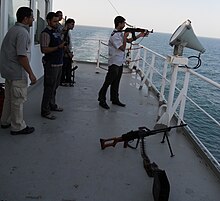
First and foremost, the best protection against piracy is simply to avoid encountering them. This can be accomplished by using tools such as radar.[94]
In addition, while the non-wartime 20th century tradition has been for merchant vessels not to be armed, the U.S. Government has recently changed the rules so that it is now "best practice" for vessels to embark a team of armed private security guards.[95][96] In addition, the crew themselves can be given a weapons training,[97] and warning shots, using less-lethal ammunition, can be fired legally in international waters and/or when sailing under Israeli or Russian flag[dubious – discuss]. Finally, similar to weapons training, remote weapon systems can be implemented to a vessel.[98]
Other measures vessels can take to protect themselves against piracy are implementing a high freewall[99] and vessel boarding protection systems (e.g., hot water wall, electricity-charged water wall, automated fire monitor, slippery foam).[100] Ships can also attempt to protect themselves using their Automatic Identification Systems (AIS).[101] Every ship over 300 tons carries a transponder supplying both information about the ship itself and its movements. Any unexpected change in this information can attract attention. Previously this data could only be picked up if there was a nearby ship, thus rendering single ships vulnerable. However, special satellites have been launched recently that are now able to detect and retransmit this data. Large ships cannot therefore be hijacked without being detected. This can act as a deterrent to attempts to either hijack the entire ship or steal large portions of cargo with another ship since an escort can be sent more quickly than might otherwise have been the case.
Finally, in an emergency, warships can be called upon. In some areas such as near Somalia, naval vessels from different nations are present that are able to intercept vessels attacking merchant vessels. For patrolling dangerous coastal waters (and/or keeping financial expenses down), robotic or remote-controlled USVs are also sometimes used.[102] Also, both shore-launched and vessel-launched UAVs are also used by the U.S. Army.[103][104]
Commerce raiders
A wartime activity similar to piracy involves disguised warships called commerce raiders or merchant raiders, which attack enemy shipping commerce, approaching by stealth and then opening fire. Commerce raiders operated successfully during the American Revolution. During the American Civil War, the Confederacy sent out several commerce raiders, the most famous of which was the CSS Alabama. During World War I and World War II, Germany also made use of these tactics, both in the Atlantic and Indian Oceans. Since commissioned naval vessels were openly used, these commerce raiders should not be considered even privateers, much less pirates— although the opposing combatants were vocal in denouncing them as such.
National law
The examples and perspective in this article may not represent a worldwide view of the subject. (October 2013) |
United Kingdom

Section 2 of the Piracy Act 1837 creates a statutory offence of aggravated piracy. See also the Piracy Act 1850.
In 2008 the British Foreign Office advised the Royal Navy not to detain pirates of certain nationalities as they might be able to claim asylum in Britain under British human rights legislation, if their national laws included execution, or mutilation as a judicial punishment for crimes committed as pirates.[105]
Definition of piracy jure gentium
See section 26 of, and Schedule 5 to, the Merchant Shipping and Maritime Security Act 1997. These provisions replace the Schedule to the Tokyo Convention Act 1967. In Cameron v HM Advocate, 1971 SLT 333, the High Court of Justiciary said that that Schedule supplemented the existing law and did not seek to restrict the scope of the offence of piracy jure gentium.
See also:
- Re Piracy Jure Gentium [1934] AC 586, PC
- Attorney General of Hong Kong v Kwok-a-Sing (1873) LR 5 PC 179
Jurisdiction
See section 46(2) of the Senior Courts Act 1981 and section 6 of the Territorial Waters Jurisdiction Act 1878. See also R v Kohn (1864) 4 F & F 68.
Piracy committed by or against aircraft
See section 5 of the Aviation Security Act 1982.
Sentence
The book "Archbold" said that in a case that does not fall with section 2 of the Piracy Act 1837, the penalty appears to be determined by the Offences at Sea Act 1799, which provides that offences committed at sea are liable to the same penalty as if they had been committed upon the shore.[106]
History
William Hawkins said that at common law, piracy by a subject was esteemed to be petty treason. The Treason Act 1351 provided that this was not petty treason.[107]
In English admiralty law, piracy was classified as petit treason during the medieval period, and offenders were accordingly liable to be drawn and quartered on conviction. Piracy was redefined as a felony during the reign of Henry VIII. In either case, piracy cases were cognizable in the courts of the Lord High Admiral. English admiralty vice-admiralty judges emphasized that "neither Faith nor Oath is to be kept" with pirates; i.e. contracts with pirates and oaths sworn to them were not legally binding. Pirates were legally subject to summary execution by their captors if captured in battle. In practice, instances of summary justice and annulment of oaths and contracts involving pirates do not appear to have been common.[citation needed]
United States
In the United States, criminal prosecution of piracy is authorized in the U.S. Constitution, Art. I Sec. 8 cl. 10:
The Congress shall have Power ... To define and punish Piracies and Felonies committed on the high Seas, and Offences against the Law of Nations;
Title 18 U.S.C. § 1651 states:
Whoever, on the high seas, commits the crime of piracy as defined by the law of nations, and is afterwards brought into or found in the United States, shall be imprisoned for life.
Citing the United States Supreme Court decision in the year 1820 case of United States v. Smith,[108] a U.S. District Court ruled in 2010 in the case of United States v. Said that the definition of piracy under section 1651 is confined to "robbery at sea." The piracy charges (but not other serious federal charges) against the defendants in the Said case were dismissed by the Court.[109]
International law
Effects on international boundaries
During the 18th century, the British and the Dutch controlled opposite sides of the Straits of Malacca. The British and the Dutch drew a line separating the Straits into two halves. The agreement was that each party would be responsible for combating piracy in their respective half. Eventually this line became the border between Malaysia and Indonesia in the Straits.
Law of nations

Piracy is of note in international law as it is commonly held to represent the earliest invocation of the concept of universal jurisdiction. The crime of piracy is considered a breach of jus cogens, a conventional peremptory international norm that states must uphold. Those committing thefts on the high seas, inhibiting trade, and endangering maritime communication are considered by sovereign states to be hostis humani generis (enemies of humanity).[110]
For a different opinion on Pirates as Hostis Humani Generis see Caninas, Osvaldo Peçanha. Modern Maritime Piracy: History, Present Situation and Challenges to International Law. Paper presented at the annual meeting of the ISA – ABRI JOINT INTERNATIONAL MEETING, Pontifical Catholic University, Rio de Janeiro Campus (PUC-Rio), Rio de Janeiro, Brazil, Jul 22, 2009
Because of universal jurisdiction, action can be taken against pirates without objection from the flag state of the pirate vessel. This represents an exception to the principle extra territorium jus dicenti impune non paretur ("One who exercises jurisdiction out of his territory is not obeyed with impunity").[111]
International conventions
Articles 101 to 103 of UNCLOS

Articles 101 to 103 of the United Nations Convention on the Law of the Sea (UNCLOS) (1982) contain a definition of piracy iure gentium.[112] They read:
Article 101Definition of piracy
Piracy consists of any of the following acts:
- (a) any illegal acts of violence or detention, or any act of depredation, committed for private ends by the crew or the passengers of a private ship or a private aircraft, and directed—
- (i) on the high seas, against another ship or aircraft, or against persons or property on board such ship or aircraft;
- (ii) against a ship, aircraft, persons or property in a place outside the jurisdiction of any State;
- (b) any act of voluntary participation in the operation of a ship or of an aircraft with knowledge of facts making it a pirate ship or aircraft;
- (c) any act of inciting or of intentionally facilitating an act described in subparagraph (a) or (b).
Article 102Piracy by a warship, government ship or government aircraft whose crew has mutinied
The acts of piracy, as defined in article 101, committed by a warship, government ship or government aircraft whose crew has mutinied and taken control of the ship or aircraft are assimilated to acts committed by a private ship or aircraft.
Article 103Definition of a pirate ship or aircraft
A ship or aircraft is considered a pirate ship or aircraft if it is intended by the persons in dominant control to be used for the purpose of committing one of the acts referred to in article 101. The same applies if the ship or aircraft has been used to commit any such act, so long as it remains under the control of the persons guilty of that act.[113]
This definition was formerly contained in articles 15 to 17 of the Convention on the High Seas signed at Geneva on April 29, 1958.[114] It was drafted[115] by the International Law Commission.[112]
A limitation of article 101 above is that it confines piracy to the High Seas. As the majority of piratical acts occur within territorial waters, some pirates are able to go free as certain jurisdictions lack the resources to monitor their borders adequately.[citation needed]
IMB definition
The International Maritime Bureau (IMB) defines piracy as:
- the act of boarding any vessel with an intent to commit theft or any other crime, and with an intent or capacity to use force in furtherance of that act.[116]
Uniformity in Maritime Piracy Law
Given the diverging definitions of piracy in international and municipal legal systems, some authors argue that greater uniformity in the law is required in order to strengthen anti-piracy legal instruments.[117]
In popular culture

Pirates are a frequent topic in fiction and, in their Caribbean incarnation, are associated with certain stereotypical manners of speaking and dress, some of them wholly fictional: "nearly all our notions of their behavior come from the golden age of fictional piracy, which reached its zenith in 1881 with the appearance of Robert Louis Stevenson's Treasure Island."[118] Some inventions of pirate culture such as "walking the plank" were popularized by J. M. Barrie's novel, Peter Pan, where Captain Hook's pirates helped define the fictional pirate archetype.[119] Robert Newton's portrayal of Long John Silver in Disney's 1950 film adaptation also helped define the modern rendition of a pirate, including the stereotypical West Country "pirate accent".[120] Other influences include Sinbad the Sailor, and the recent Pirates of the Caribbean films have helped kindle modern interest in piracy and have performed well at the box office. Assassin's Creed IV: Black Flag also revolves around pirates during the Golden Age of Piracy.
The classic Gilbert and Sullivan operetta The Pirates of Penzance focuses on The Pirate King and his hopeless band of pirates on the South coast of England. The Pirate King is widely believed to be the inspiration for Captain Jack Sparrow. The on-going manga One Piece details the adventures of Monkey D. Luffy and his crew to find the legendary treasure, The One Piece, and become the next Pirate King.
Many sports teams use "pirate" or a related term such as "raider" or "buccaneer" as their nickname, basing their gimmick around the popular stereotypes of pirates, as well as to give them an "intimidating" image. The Pittsburgh Pirates, a Major League Baseball team in Pittsburgh, Pennsylvania, are perhaps the most well-known, and actually got their nickname in 1891 after being accused of "piratical" actions by another team after they signed a player from the accusing team. The Oakland Raiders and Tampa Bay Buccaneers, both of whom play in the National Football League, also use pirate-related nicknames.
See also

References
Bibliography
- "bonaventure.org.uk – Pirate Ranks". Retrieved April 24, 2008.
- Beal, Clifford (2007). Quelch's Gold: Piracy, Greed, and Betrayal in Colonial New England. Praeger. p. 243. ISBN 0-275-99407-4.
- Burnett, John (2002). Dangerous Waters: Modern Piracy and Terror on the High Seas. Plume. p. 346. ISBN 0-452-28413-9.
- Menefee, Samuel (1996). Trends in Maritime Violence. Jane's Information Group. ISBN 0-7106-1403-9.
- Cordingly, David (1997). Under the Black Flag: The Romance and the Reality of Life Among the Pirates. Harvest Books. ISBN 0-15-600549-2.
- Girard, Geoffrey (2006). Tales of the Atlantic Pirates. Middle Atlantic Press. ISBN 0-9754419-5-7.
- Langewiesche, William (2004). The Outlaw Sea: A World of Freedom, Chaos, and Crime. North Point Press. ISBN 0-86547-581-4.
- Rediker, Marcus (1987). Between the Devil and the Deep Blue Sea: Merchant Seamen, Pirates and the Anglo-American Maritime World, 1700–1750. Cambridge University Press. ISBN 0-521-37983-0.
- Kimball, Steve (2006). The Pyrates Way Magazine. The Pyrates Way, LLC. p. 64.
- Heller-Roazen, Daniel (2009). The Enemy of All: Piracy and the Law of Nations. Zone Books. ISBN 978-1890951948.
- Lucie-Smith, Edward (1978). Outcasts of the Sea: Pirates and Piracy. Paddington Press. ISBN 9780448226170.
Further reading
- I Sailed With Chinese Pirates by Aleko Lilius, Oxford University Press, USA, October 17, 1991,ISBN 0-19-585297-4.
- Contemporary Maritime Piracy in Southeast Asia. By: Chalk, Peter. Studies in Conflict & Terrorism, January–March 1998, Vol. 21 Issue 1, p87, 26p, 1 chart; (AN 286864).
- Dangerous Waters, Modern Piracy and Terror on the High Seas, by John S. Burnett. Dutton, 2003, Plume, 2003–2004, New York. (ISBN 0-452-28413-9).
- Japanese Anti-Piracy Initiatives in Southeast Asia. By: Bradford, John. Contemporary Southeast Asia, December 2004, Vol. 26 Issue 3, p480-505, 26p; (AN 15709264).
- Maritime Piracy and Anti-Piracy Measures. By: Herrmann, Wilfried. Naval Forces, 2004, Vol. 25 Issue 2, p18-25, 6p; (AN 13193917).
- Maritime Piracy in Southeast Asia. By: Liss, Carolin. Southeast Asian Affairs, 2003, p52, 17p; (AN 10637324).
- Pirates, Fishermen and Peacebuilding – Options for Counter-Piracy in Somalia. By: Bueger, Christian, Stockbruegger, Jan and Werthes, Sascha. Contemporary Security Policy, 2011, Vol.32, No.2.
- Modern Piracy. Naval Forces, 2005, Vol. 26 Issue 5, p20-31, 7p; (AN 18506590).
- Terror on the High Seas. By: Koknar, Ali. Security Management, June 2004, Vol. 48 Issue 6, p75-81, 6p; (AN 13443749)
- Goodman, Timothy H. 'Leaving the Corsair's name to other times:' How to enforce the law of sea piracy in the 21st century through regional international agreements / Timothy H. Goodman In: Case Western Reserve Journal of International Law, vol.31 (Winter 1999) nr.1, P.: 139-168.
- Piracy:Out of Sight, Out of Mind?, Goorangai, RANR Occasional Papers, August (2006) Royal Australian Navy
- Rogue Wave: Modern Maritime Piracy and International Law, Article published on the electronic magazine The Culture & Conflict Review of the United States Naval Postgraduate School, Monterey, California by Commander Osvaldo Peçanha Caninas Article in NPS site.
- Patriot Pirates: the privateer war for freedom and fortune in the American Revolution by Robert H. Patton. New York : Pantheon Books, c2008. ISBN 9780375422843
Notes
- ^ TEDx Talk: What is Piracy?
- ^ D.Archibugi, M.Chiarugi (April 9, 2009). "Piracy challenges global governance". Open Democracy. Retrieved April 9, 2009.
- ^ Peirates, Henry George Liddell, Robert Scott, "A Greek-English Lexicon", at Perseus.
- ^ Peira, Henry George Liddell, Robert Scott, "A Greek-English Lexicon", at Perseus.
- ^ "Online Etymology Dictionary". Etymonline.com. Retrieved December 18, 2008.
- ^ Heller-Roazen, Daniel (2009). The Enemy of All: Piracy and the Law of Nations. Zone Books. ISBN 978-1890951948.
- ^ The Pirates Hold – Piracy Timeline.
- ^ Phoenician Economy and Trade.
- ^ Again, according to Suetonius's chronology (Julius 4). Plutarch (Caesar 1.8-2) says this happened earlier, on his return from Nicomedes's court. Velleius Paterculus (Roman History 2:41.3-42 says merely that it happened when he was a young man.
- ^ Plutarch, Caesar 1–2.
- ^ The Pirates of St. Tropez.
- ^ Piracy on Crete, Creta News.
- ^ H Thomas Milhorn, Crime: Computer Viruses to Twin Towers, Universal Publishers, 2004. ISBN 1-58112-489-9.
- ^ "Places which had been raided or besieged by the Cossacks".
- ^ "Cossack Navy 16th – 17th Centuries". Archived from the original on October 26, 2009.
- ^ "The History of Maritime Piracy – Stepan Razin".
- ^ Chong Sun Kim, "Slavery in Silla and its Sociological and Economic Implications", in Andrew C. Nahm, ed. Traditional Korea, Theory and Practice (Kalamazoo, MI: Center for Korean Studies, 1974)
- ^ Rommel C. Banlaoi. "Maritime Piracy in Southeast Asia: Current Situation, Counter-Measures, Achievements and Recurring Challenges" (PDF).
- ^ Findly, Elison B (April – June 1988). "The Capture of Maryam-uz-Zamani's Ship: Mughal Women and European Traders," Journal of the American Oriental Society, 108 (2): 227–238.
- ^ "Cross-Cultural Perceptions of Piracy: Maritime Violence in the Western Indian Ocean and Persian Gulf Region during a Long Eighteenth Century".
- ^ "Soldiers, Seahawks and Smugglers".
- ^ "The Buginese of Sulawesi".
- ^ "Pirates of the East".
- ^ "Wanderings Among South Sea Savages And in Borneo and the Philippines by H. Wilfrid Walker".
- ^ David P. Forsythe (2009). "Encyclopedia of Human Rights, Volume 1". Oxford University Press. p. 464. ISBN 0195334027
- ^ "When Europeans were slaves: Research suggests white slavery was much more common than previously believed".
- ^ "Christian Slaves, Muslim Masters: White Slavery in the Mediterranean, the Barbary Coast and Italy, 1500–1800". Robert Davis (2004) ISBN 1-4039-4551-9
- ^ Gemma Pitcher, Patricia C. Wright. " Madagascar & Comoros " p. 178.
- ^ "Libertatia".
- ^ Lucie-Smith, Edward (1978). Outcasts of the Sea: Pirates and Piracy. Paddington Press. ISBN 9780448226170.
- ^ Tortuga - Pirate History - The Way Of The Pirates
- ^ Nigel Cawthorne (2005), Pirates: An Illustrated History, Arturus Publishing Ltd., 2005, p. 65.
- ^ Cawthorne, p. 34, 36, 58
- ^ Peter Earle (2003), The Pirate Wars, ISBN 0-312-33579-2, p. 94.
- ^ Earle, p. 148.
- ^ Geoffrey Parker, ed. (1986), The World: An Illustrated History, Times Books Ltd., p. 317.
- ^ Mark Kurlansky, Cod: A Biography of the Fish That Changed the World. Penguin, 1998.
- ^ 'William III, 1698-9: An Act for the more effectual suppression of Piracy. [Chapter VII. Rot. Parl. 11 Gul. III. p. 2. n. 5.]', Statutes of the Realm: volume 7: 1695-1701 (1820), pp. 590-94. URL: http://www.british-history.ac.uk/report.asp?compid=46966. Date accessed: 16 February 2007.
- ^ a b Cite error: The named reference
Max 2009was invoked but never defined (see the help page). - ^ Oren, Michael B. (November 3, 2005). "The Middle East and the Making of the United States, 1776 to 1815". Retrieved February 18, 2007.
- ^ Cite error: The named reference
EB1911was invoked but never defined (see the help page). - ^ "From Pirate Coast To Trucial".
- ^ Leeson, Peter T. "An-arrghchy: The Law and Economics of Pirate Organization." Journal of Political Economy 115, no. 6 (2007): 1049–1094. pg 1066 University of Chicago
- ^ Liz Burlingame (August 23, 2013). "Sunken Treasures: The World's Most Valuable Shipwreck Discoveries". The Weather Channel.
- ^ Piratesofamerica.com[dead link]
- ^ a b c "Treasure". Retrieved April 21, 2009.
- ^ The Hudson River Valley Institute
- ^ University of Notre Dame
- ^ Gosse, Philip (2007). The Pirates' Who's Who. BiblioBazaar, LLC. ISBN 1-4346-3302-0. p. 251.
- ^ Hickox, Rex (2007). All You Wanted to Know about 18th Century Royal Navy. Lulu.com. ISBN 1-4116-3057-2. p. 16.
- ^ Hill, J.R. (2002). The Oxford Illustrated History of the Royal Navy. Oxford University Press. ISBN 0-19-860527-7. p. 157.
- ^ Current value is based on the average annual income for the respective years.
- ^ Nelson and His Navy – Prize Money Historical Maritime Society.
- ^ Pirates by John Matthews
- ^ "The New Cambridge Modern History: Volume 4, The Decline of Spain and the Thirty Years War, 1609-48/49". J. P. Cooper (1979). p.229. ISBN 0-521-29713-3
- ^ Rees Davies, British Slaves on the Barbary Coast, BBC, July 1, 2003.
- ^ Kelsey, Harry, Sir Francis Drake; The Queen's Pirate, Yale University Press, New Haven, 1998, ISBN 0-300-07182-5.
- ^ a b c Privateering and the Private Production of Naval Power, Gary M. Anderson and Adam Gifford Jr.
- ^ Brewer, John. The Sinews of Power: War, Money, and the English State, 1688–1783. New York.: Alfred A. Knopf, 1989. p. 197.
- ^ Privateers or Merchant Mariners help win the Revolutionary War.
- ^ Privateers.
- ^ US Navy Fleet List War of 1812.
- ^ Oren, Michael B. (November 3, 2005). "The Middle East and the Making of the United States, 1776 to 1815". Retrieved February 18, 2007.
- ^ The Confederate Privateers.
- ^ "Foreign Affairs – Terrorism Goes to Sea". Retrieved December 8, 2007.
- ^ "Piracy in Asia: A Growing Barrier to Maritime Trade". Retrieved December 8, 2007.
- ^ Krane, Jim (March 19, 2006). "U.S. Navy warships exchange gunfire with suspected pirates off Somali coast". The Seattle Times. Retrieved January 18, 2007.
- ^ "Brazil creating anti-pirate force after spate of attacks on Amazon riverboats". The Guardian. June 17, 2011.
- ^ Riječni gusari u Srbiji pljačkaju hrvatske brodove Template:Sr icon
- ^ Ukrainian Danube Shipping Company Says Its Ships Are Being Attacked Frequently In Romanian Part Of River Danube
- ^ Romanian Pirats Attack Ukrainian Ships More Frequently Template:Uk icon
- ^ BBC Piracy documentary.
- ^ Piracy at Somalian coasts.
- ^ Security Management:Piracy on the high seas. Retrieved October 23, 2007.
- ^ ICC Commercial Crime Services: IBM Piracy Report 2007. Retrieved January 22, 2008. [dead link]
- ^ World pirate attacks surge in 2009 due to Somalia
- ^ "Anarchy at Sea" Atlantic Monthly. September 2003.
- ^ "Pirates Open Fire on Cruise Ship off Somalia". The Washington Post. November 5, 2005. Retrieved November 14, 2005.
- ^ "Whaling acid attack terrorist act: Japan". Reuters via The Sydney Morning Herald. February 9, 2007. Retrieved February 11, 2007.
- ^ Bousquet, Earl (July 23, 2001). "Ocean Warriors Confront Lucian Fishermen". Government of Saint Lucia web site. Retrieved February 11, 2007.
- ^ "Piracy is still troubling the shipping industry: report; Industry fears revival of attacks though current situation has improved," The Business Times Singapore. August 14, 2006.
- ^ "The economics of Somali piracy," The Washington Post, March 3, 2013 2007.
- ^ Abdi Guled, Jason Straziuso (September 25, 2012). "AP IMPACT: Party seems over for Somali pirates". AP. Retrieved October 3, 2012.
- ^ a b c Alaric Nightingale, Michelle Wiese Bockmann (October 22, 2012). "Somalia Piracy Falls to Six-Year Low as Guards Defend Ships". Bloomberg News. Retrieved October 25, 2012.
- ^ Apps, Peter (February 10, 2013). "Have hired guns finally scuppered Somali pirates?". Reuters. Retrieved March 16, 2013.
- ^ Maritimesecurity.com article, Guns On Board.
- ^ Thomas Buergenthal & Sean D. Murphy, Public International Law in a Nutshell, p. 211, West Group (3d ed. 2002).
- ^ Thomas Buergenthal & Sean D. Murphy, Public International Law in a Nutshell, p. 211-212, West Group (3d ed. 2002), citing generally K. Randall, Universal Jurisdiction Under International Law, 66 Tex. L. Rev. 785 (1988).
- ^ "Whoever, on the high seas, commits the crime of piracy as defined by the law of nations, and is afterwards brought into or found in the United States, shall be imprisoned for life." See 18 U.S.C. § 1651.
- ^ Stephens, Bret (November 25, 2008). "Why Don't We Hang Pirates Anymore?". The Wall Street Journal.
- ^ "NATO frees 20 hostages; pirates seize Belgian ship". Associated Press. April 18, 2009.[dead link]
- ^ Leeson, Peter T. (April 13, 2009). "Want to Prevent Piracy? Privatize the Ocean". National ReviewTemplate:Inconsistent citations
{{cite journal}}: Cite journal requires|journal=(help)CS1 maint: postscript (link) - ^ Stossel, John and Kirell, Andrew (May 8, 2009). "Could Profit Motive Put an End to Piracy?". ABC NewsTemplate:Inconsistent citations
{{cite journal}}: Cite journal requires|journal=(help)CS1 maint: multiple names: authors list (link) CS1 maint: postscript (link) - ^ Anti-piracy radar
- ^ "Loaded: Freighters Ready to Shoot Across Pirate Bow", by John W. Miller, Wall Street Journal, January 5, 2009
- ^ "Maersk Alabama "Followed Best Practice"", by Bob Couttie, November 20, 2009, Maritime Accident Casebook
- ^ Weapons training for crew
- ^ What can be done to counter piracy?
- ^ High wall providing extra protection
- ^ Hot/electricity charged water wall
- ^ BBC,[1] Satellite tracking of AIS
- ^ Robotic/remote-controlled USVs
- ^ Vessel-launched UAV's
- ^ Shore-launched UAVs
- ^ Woolf, Marie (April 13, 2008). "Pirates can claim UK asylum". The Sunday Times. London. Retrieved April 22, 2009.
- ^ Archbold Criminal Pleading, Evidence and Practice, 1999, para. 25–46 at p. 1979
- ^ Hawkin's Treatise of Pleas of the Crown (1824 ed.) vol.1, chapter XIV (from Google Books). See also 40 Ass. 35
- ^ 18 U.S. 153 (1820).
- ^ Memorandum Opinion and Order, Aug 17, 2010, docket entry 94, United States v. Said, 2:10-cr-00057-RAJ-FBS, U.S. District Court for the Eastern District of Virginia (Norfolk Div.).
- ^ Kissinger, Henry (July/August 2001). "The Pitfalls of Universal Jurisdiction". Foreign Affairs.
{{cite news}}: Check date values in:|date=(help) - ^ Black's Law Dictionary, p. 528 (5th ed. 1979).
- ^ a b Archbold Criminal Pleading, Evidence and Practice. 1999. Paragraph 25–39 at page 1976.
- ^ "United Nations Convention on the Law of the Sea (UNCLOS) of 10 December 1982, Part VII: High Seas".
- ^ Archbold Criminal Pleading, Evidence and Practice. 1999. Paragraph 25–39 at page 1976 refers to the Schedule to the Tokyo Convention Act 1967. That Schedule, and section 4 of that Act, refer to the said articles of Convention on the High Seas.
- ^ Yearbook of the ILC [1956] Vol 2, 282
- ^ "cargolaw.com".
- ^ "Bento, Lucas, 'Toward An International Law of Piracy Sui Generis: How the Dual Nature of Maritime Piracy Law Enables Piracy to Flourish' Berkeley Journal of International Law Vol.29:2 (2011)". ssrn.com.
- ^ Adams, C. "The Straight Dope", October 12, 2007 The Straight Dope – Fighting Ignorance Since 1973
- ^ Bonanos, Christopher. "Did pirates really say "arrrr"? – By Christopher Bonanos – Slate Magazine". Slate.com. Retrieved December 18, 2008.
- ^ Angus Konstam (2008) Piracy: The Complete History P. 313. Osprey Publishing. Retrieved October 11, 2011
External links
- Shearer, Ivan. Piracy, Max Planck Encyclopedia of Public International Law.
- Archibugi, Chiarugi. Piracy Challenges Global Governance, Open Democracy.
- Bowden, Anna et al. The Economic Cost of Maritime Piracy One Earth Future, December 2010
- Kontorovich, Eugene. Piracy and International Law, [Global Law Forum].
- Turbulent Waters in a Maritime Black Hole The Hague Centre for Strategic Studies, May 2008.
- ONI Worldwide Threats to Shipping Reports, Weekly.
- IMB Piracy Reporting Center Weekly Piracy Report.
- Piracy and armed robbery against ships (International Maritime Organization).
- European Union Naval Force Somalia – Operation Atalanta The European Union is conducting a military operation to help combat piracy in the Gulf of Aden.
- Piracy: A Legal Definition Congressional Research Service
- Piracy Studies An academic reference page, research blog and bibliography on contemporary maritime piracy.
- Oudman, Sergei Piracy Jure Gentium & International Law E-International Relations Paper.
- Pirated Spanish Galleon of La Consolación ("Isla de Muerto shipwreck") 1681.
- National Geographic article on modern pirates in Malacca Straits.
- M. Biard's 1861 drawing of Pirates, published in Harper's Weekly.
- ONI Worldwide Threats to Shipping Reports, Weekly.
- Maritime Terrorism Research Center.
- Maritime Piracy: Implications for Maritime Energy Security.
- Maritime Security & Counter-Piracy: Strategic Adaptations and Technological Options.
- Jameson, John Franklin.
- Privateering and Piracy in the Colonial Period: Illustrative Documents at Project Gutenberg.
- Monday May 11, 2009, Giles Tremlett, Somali pirates guided by London intelligence team, report says @guardian.co.uk – Document obtained by Spanish radio station says 'well-placed informers' in constant contact by satellite telephone
- Webcast Lecture on the use of pirates in the American Revolution by Robert H. Patton at the Pritzker Military Library on March 14, 2009
Template:Link GA Template:Link FA Template:Link FA Template:Link FA


